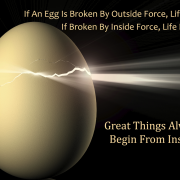Deep Innovation Design
THE QUEST FOR MORE INNOVATION
The last five to ten years, pretty much any business and any government was pushing for more innovation. But if somebody was asked “How do I innovate? Tell me step by step”, there was no tangible answer. When I was asked that very question, in particular the “step by step” part, it daunted to me, that there was simply no answer that could satisfy this question. Tens of thousands of consultants help people to “open their mind”, other use the “design thinking” model to process ideas – actually very well. But the question remains: “How do you CREATE those innovative ideas” that you can then process in a design thinking model!
INNOVATION ON DEMAND
Innovation was an accidental event – a combination of many instances, experiences and the brain pushed out an idea. Mostly it was big enough to warrant starting a whole new business. NOW – today we have a situation where we don’t want to have an accidental brain flash leading to a possible innovation. In times where we have a crisis we actually would want to have solutions on demand. But as long as we don’t even know how ideas are created, we are far away from creating ideas on demand.
THE BIG SHIFT IN INNOVATION HISTORY
Neuroscientists helped me understand that human beings are not really creative – we can only COMPOSE ideas from past experiences, from whatever we saw, heard, felt and so forth. All new experiences are actually get associated with existing experiences and create some interesting IDEAS of which we actually don’t really know. The biggest idea machine is our mind when we sleep. There is much to explain but the net of it is: We are not creative and we create ideas by the millions. So what is the problem?
Our life, our culture, our education and our brain itself, are all conditioned to allow only the most obvious and the least demanding deas to pop up. ONly 1 in a trillion or less is actually making it from our right brain to the left and stimulates a communication between the two that forms a “thought” that may break through all the other barriers. And once we understand that process, we have the foundation for creating innovation on demand, like we create a house or bridge or as simple as a paper plane.
DEEP INNOVATION DESIGN
in 2016 we began our first careful attempts to help startups to come up with disruptive business models. What was a one of a million chance we were able to get more than 50% of the startups coming up with disruptive models. Creating, what we call a “Disruptive Moment” was defined as an innovative idea that will push competitors to change their course in order to catch up with these startups. It was an early attempt to get this done. in the past two years we went deeper into the “mechanics of our mind” to learn what we need to actually DO to play with our billions of neurons and synapses to form those innovative ideas. After two years of work we found an early concept that works well enough to come up with innovative solutions whenever we want, using the deep innovation design method:
Four ‘T”s one “M” of Deep Innovation Design
1) TALENT
We need talents that are talented for creating innovation like others are talented to play music, paint pictures, drive race cars, cook amazing meals, create fashion, help others or simply entertain people.
2) TEAM
Like a music band, or a football team, innovation is a team sport – if you do it alone you end up waiting for accidental ideas. And one of the most important player in the “Innovation Play”, are the affected people: Customers, users, victimes, if you start the game without them you are doomed to lose. And if your actors (innovators) are all of the same trade, you will lose as well. Diversity is the magic formula. Understanding that part makes it also very obvious why enterprises CANNOT be innovative. They try to surprise the customer with their ideas and the ideas come from a mono culture called R&D center, engineering teams or other experts.
3) TRAINING
Our brain is an old machine with lots of upgrades. More upgrades than any other organ in our human apparatus. It is also the most adaptive body part. To overcome some of the 300,000 year old habits and some even go back 5 million years we need to train our brain. I often wonder how long our children would crawl if we never help them to walk. We need to train our bran in opening a treasure chest that is heavily guarded by about 200 million nerve strands or Axons, our so called Corpus Callosum.
With good talents and a great team we actually can.
4) TOOLS
You know the say “I think my head explodes”- right. And that is always when you reach your capacity limits of learning or thinking, or comprehending – or – innovating. In an interesting way, it’s all the same. Since the last 12,000 years we experience this more and more often and we built more and more tools and ever bigger teams to deal with exactly that problem. And so also we developed tools, methods and finally technology that shall help us to go through this rather demanding process. And guess what – it is no different from what athletes perform in their contests, musicians on stage, race driver on the street or on the water, and so forth. We realized that we can easily loos one or two Kilo of body weight, during such processes.
5) MARKET
Here is when the rubber meets the road. There are an estimated 100 Million patents in drawers that have been never used. The initial value of an innovation is exactly ZERO. The value then grows with the size of its distribution. We can be as innovative as we want – if we can make it available to a market or the market is not interesting, the value remains to be zero. In the end, sales channels, creative marketing, service and support organizations, transport (and if it the Internet) are ky to the success of any innovation. This success is seen best, when we look through the macroeconomic lense: A company creates a product. It is sold through distribution and dealer channels, it is shipped across all oceans, it is serviced locally, maybe education organizations provide training, maybe consulting companies help apply the product. At the same time new ideas pop up from companies that build add-ons to that product and create the same sub-market and all of a sudden a company with 5,000 employees actually creates 50,000 indirect jobs.
How to start from here
On April 23, the Society3 Group who worked on the Deep Innovation Design Model for four years is providing a free online seminar (webinar) and explaining how the Deep Innovation Design Model works, where you can get trained and how you get involved in this new model. www.society3.com/webinars/. The World Innovations Forum is providing the training programs and support in emerging countries and is able to provide stipends for talented innovators to learn how to be extremely innovative.






Leave a Reply
Want to join the discussion?Feel free to contribute!